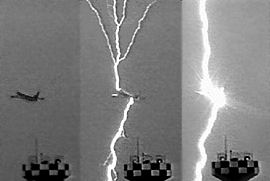10 April 2013
Radiation exposure from "dark lightning" quantified
by Will Parker

Over the last decade, scientists learnt that thunderstorms are capable of generating brief but powerful bursts of gamma-rays called terrestrial gamma-ray flashes (TGFs). These flashes of gamma-rays are so bright they can blind instruments many hundreds of kilometers away in outer space. Because they can originate at the same altitudes at which commercial aircraft fly, scientists have been trying to determine whether or not these gamma ray flashes present a radiation hazard to individuals in planes.
The work to answer that question was previously hampered by a poor understanding of exactly how these gamma-rays are generated by thunderstorms, with initial dose estimates ranging from not-so-safe to downright scary. Now, however, scientists at Florida Tech have developed a physics-based model of exactly how thunderstorms manage to produce high-energy radiation. The new work was presented today at a press conference meeting of the European Geosciences Union in Vienna, Austria.
According to the new model, instead of creating normal lightning, thunderstorms can sometimes produce an exotic kind of electrical breakdown that involves high-energy electrons and their anti-matter equivalent called positrons. The interplay between the electrons and positrons causes an explosive growth in the number of these high-energy particles, emitting the observed terrestrial gamma ray flashes while rapidly discharging the thundercloud. Even though copious gamma-rays are emitted by this process, very little visible light is produced, creating a kind of electrical breakdown within the storms that the researchers call "dark lightning."
The new model of dark lightning can explain many of the observed properties of terrestrial gamma ray flashes. The model also calculates the radiation doses received by individuals inside aircraft that happen to be in exactly the wrong place at the wrong time. Near the tops of the storms, for the types of TGFs that can be seen from space, the radiation doses are equivalent to about 10 chest x-rays, or about the same radiation people would receive from natural background sources over one year.
"However, near the middle of the storms, the radiation dose could be about 10 times larger, comparable to some of the largest doses received during medical procedures and roughly equal to a full-body CT scan," said researcher Joseph Dwyer, from the Florida Institute of Technology.
"Although airline pilots already do their best to avoid thunderstorms, occasionally aircraft do end up inside electrified storms, exposing passengers to terrestrial gamma ray flashes. On rare occasions," Dwyer adds, "it may be possible that hundreds of people, without knowing it, may be simultaneously receiving a sizable dose of radiation from dark lightning." It is not known yet how often this actually occurs, but Dwyer and his co-researchers hope to conduct further investigations to answer that question.
Related:
Discuss this article in our forum
Study Of Runaway Breakdown Set For Lab
Ball lightning an ion discharge, contends Aussie scientist
Radiation exposure impacting gender ratio
Source: Florida Institute of Technology
